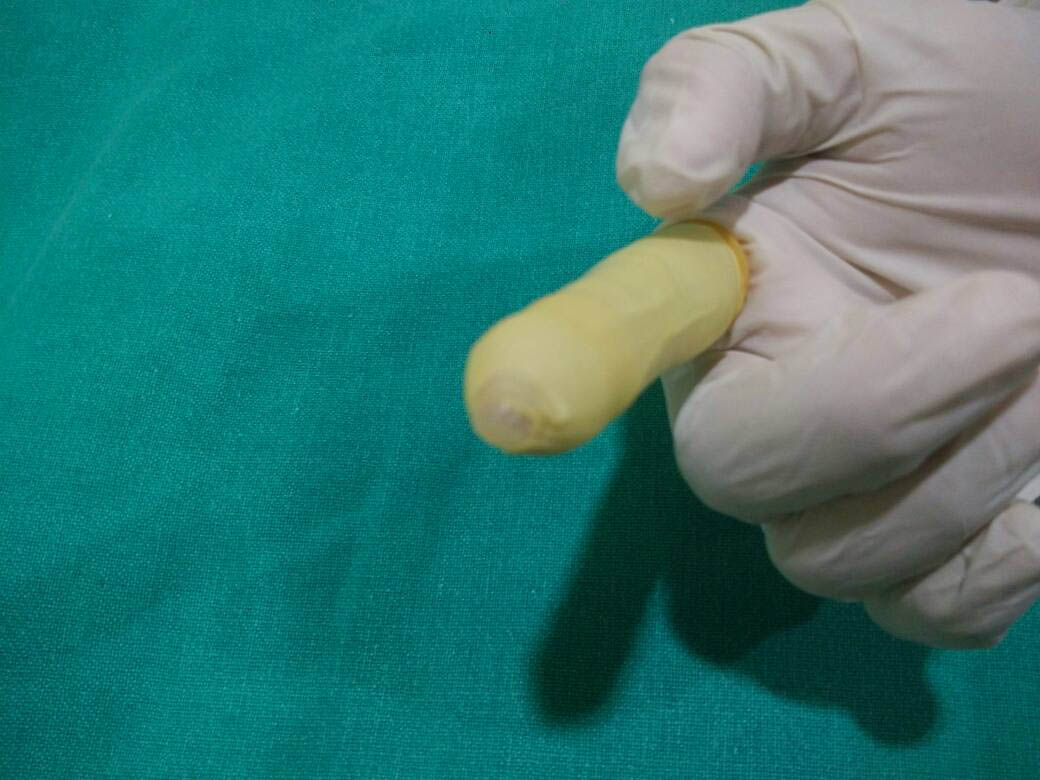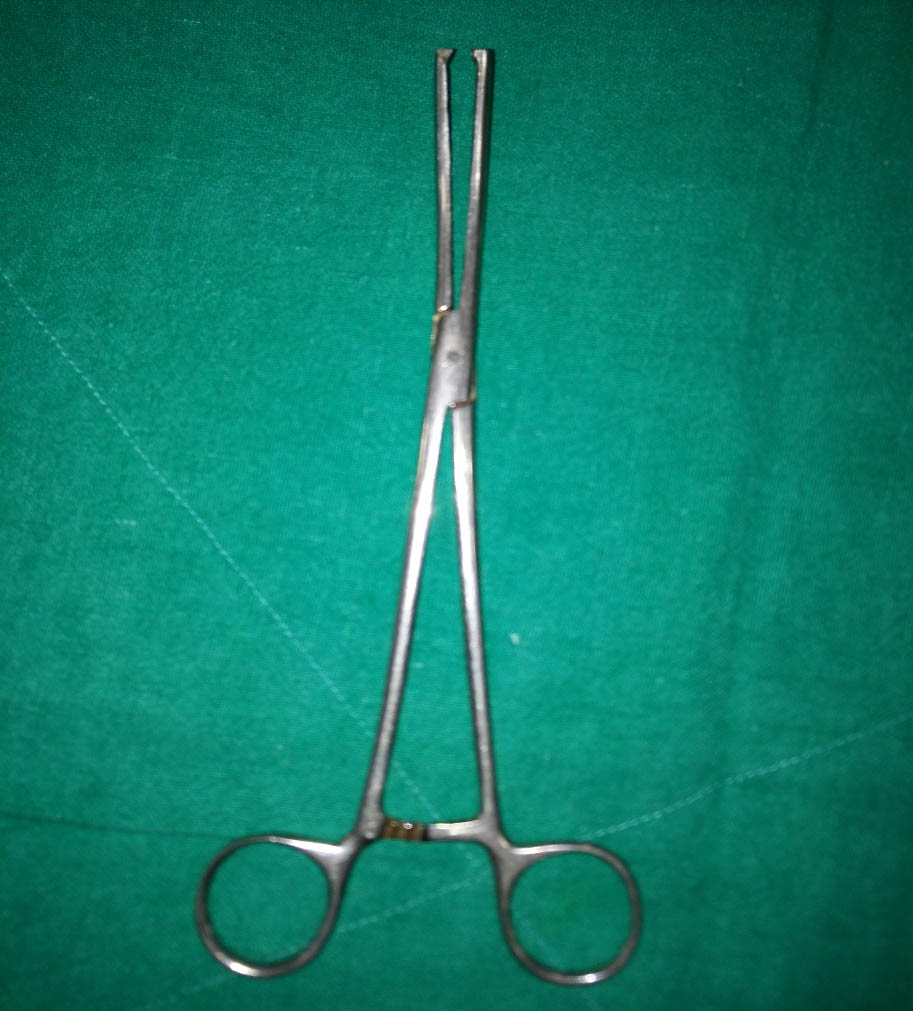Materials and Methods
It was a prospective, single-blinded, randomised study done in the labour room of Obstetrics and Gynaecology Department of Hamdard Institute of Medical Sciences & Research over a period of six months from Jan 2017 to July 2017. Purposive sampling was done. Informed written consent was taken from each patient in their own language. Ethical clearance was taken from the institutional ethical committee.
All the admitted term gestation patients in labour room requiring ARM for any indication whether in the latent or in the active phase were randomized in two groups using computer generated number. Patients with even IPD number were grouped as ‘A’ (study group) in which ARM was done with amnitear & Group ‘K’ (control group) constituted the patients with odd IPD number in which ARM was done with conventional method (kocher’s clamp). Patients were managed according to the standard hospital protocols of the department and ARM was done according to obstetrical indication under all aseptic precautions. There were 60 patients in each group. Any patient in whom ARM was to be done for any indication with vertex presentation were included in the study. Routine precautions like fixing the head abdominally in cases of non-engaged head, slow drainage of liquor after procedure, foetal heart rate monitoring before and after the procedure were taken to prevent the complications like cord prolapse or abruption. Women who were having prior leaking or absent membranes and malpresentations like breech were excluded from the study.
In group A, after doing per-vaginum examination if the patient deemed fit for ARM, amnitear [Table/Fig-1] was worn over index finger. Index finger was slightly flexed so that direction of amnitear was away from vaginal walls. Once the middle finger was inside the cervix, index finger is straightened up to scratch the membranes. In group K, after doing per vaginum examination, kocher’s forceps [Table/Fig-2] was introduced under the guidance of two fingers to prevent injury to the vaginal walls. On reaching into the cervical os, instrument was opened and membranes were scratched between the two jaws.


This study revealed the efficacy and safety of amnitear. Its outcome was compared in terms of patient’s and doctor’s comfort level in relation to kocher’s clamp. Pain and discomfort during the procedure felt by the patient was assessed with the help of Visual Analogue Scale (VAS) scoring system [7]. Obstetrician comfort level was assessed by the experience felt by the concerned doctor in terms of excellent, good and poor.
Statistical Analysis
Data was entered on the Microsoft Excel sheet and SPSS version 20 was used to do the statistical analysis. Data was expressed as mean±SD, percentages and comparison was done using unpaired student t-test. Level of significance was taken as p<0.05.
Results
This prospective randomized study included two groups (Group A & Group K) and both the groups were equally distributed in terms of baseline characteristics like age, religion, education, gravidity, parity & living issues to remove the bias. The demographic profile of the groups was comparable as shown in [Table/Fig-3].
Baseline Characteristics of the control and the study group.
| GROUP A (Study group) (60) | GROUP K (Control group) (60) | p-value |
|---|
| Mean age (years) | 25.5±4.1 | 25.9±4.2 | 0.62 |
| Religion |
| Hindu | 30 (50) | 40 (66.7) | 0.30 |
| Muslim | 30 (50) | 20 (33.3) |
| Education status |
| Illiterate | 6 (10) | 8 (13.3) | 1.00 |
| Literate | 54 (90) | 52 (86.7) |
| Gravida |
| Primi | 28 (46.7) | 28 (46.7) | 0.38 |
| Two | 16 (26.7) | 26 (43.3) |
| Three | 8 (13.3) | 2 (3.3) |
| Four | 6 (10.0) | 4 (6.7) |
| Five | 2 (3.3) | 0 |
| Parity |
| Nulli | 34 (56.7) | 36 (60.0) | 0.58 |
| One | 20 (33.3) | 22 (36.7) |
| ≥Two | 6 (10.0) | 2 (3.3) |
| Abortion |
| 0 | 38 (63.3) | 48 (80.0) | 0.32 |
| 1 | 16 (26.7) | 10 (16.7) |
| 2 | 6 (10.0) | 2 (3.3) |
| Living issue |
| 0 | 34 (56.7) | 38 (63.3) | 0.57 |
| 1 | 20 (33.3) | 20 (33.3) |
| ≤2 | 6 (10.0) | 2 (3.3) |
All the patients in group K (Kocher’s clamp) were having contractions at the time of ARM whereas in group A, 8 (13.33%) were not having any contractions but this data was not statistically significant.
In Group A, 42 (70 %) patients were in latent phase and in group K, 26(43.3%) were in latent phase, rest of the patients were in the active phase. Forty (66.7%) were having bag of membranes in group A and in group B, 38 (63.3%) were having bag of membranes at the time when ARM was performed. But these differences were statistically insignificant. Among the women in which ARM was done in latent phase, none of the patients in group A and 20 women in group K required lithotomy position for the procedure.
A statistical significant difference was found in number of attempts in doing ARM and doctors level of comfort as shown in [Table/Fig-4]. The [Table/Fig-4] shows that the comfort level was significantly better in amnitear group as compare to kocher’s group.
Comparison of different parameters in both the groups.
| Number of attempts for ARM | GROUP A (60) | GROUP K (60) | p-value |
|---|
| 1 | 56 (93.3) | 38 (63.3) | 0.02 |
| 2 | 2 (3.3) | 10 (16.7) |
| >2 | 2 (3.3) | 12 (20.0) |
| Doctors level of comfort (Subjective Perception) |
| Good | 10 (16.7) | 48 (80.0) | <0.001 |
| Excellent | 50 (83.3) | 2 (3.3) |
| Poor | 0 | 10 (16.7) |
| VAS score | | | |
| Mean | 3.3±1.8 | 5.0±2.0 | 0.69 |
Patient pain perception was assessed with help of Visual Analogue scoring. Amnitear (Group A) group was having less mean VAS score in comparison of Kocher’s group but this data was not statistically significant. Pain perception in women in which ARM was done in latent phase was also statistically insignificant in both the groups.
No complication like cord prolapse or abruption was noted in our study. But it requires careful introduction in the vagina so that it may not touch the vaginal walls as in one of the cases it caused vaginal bleeding while introduction and required stitching postpartum.
Discussion
This is probably the first Indian study to assess the efficacy of amnitear. ARM is a common method used for inducing the labour and has been shown to be efficacious in reducing the duration of labour [1,8,9]. It has been shown to decrease the rate of dystocia and caesarean section. It is one of the most common obstetrical procedures performed in the labour room. It appears to be simple procedure but becomes tricky when it is to be done in early stages of labour and in uncooperative women even in best of the hands [10].
From the present study we can conclude that, among the options available for artificial rupture of membranes, Amnitear is having the following advantages over other conventional methods i.e., it can be used in cases of lesser cervical dilation, it causes less pain, discomfort and anxiety as compared with other more obtuse amniotic perforation instruments, increased accuracy as the clinician has greater tactile feedback and can more precisely apply the hook for membrane incision, eliminates the need for an assistant as the user’s other hand is free to stabilize the presenting part, eliminates the need for patient to assume the lithotomy position when the cervix is posterior, sterile & disposable, low Cost (8 Rupees per piece) and outer teardrop shape indicates orientation of hook. Although, no head to head analysis was done regarding the cost of the amnitear.
This is commonly used device in West but there are no studies to compare the efficacy on literature search. There is only one study by Harris M et al., where they have studied the effect in 100 women in established labour. They compared two devices currently used for amniotomy, the Amnihook, a long rigid instrument and the Amnicot, a finger stall with a plastic hook on the end. They found overall no difference in operator ease of use or maternal discomfort. There were significantly fewer babies with long scratches p=0.02, Odds ratio 0.19 (95% CI 0.05 to 0.68) and the mean scratch length was almost halved in the Amnicot group (p<0.05, 95% CI for difference between means 0.653 to 6.71) [11]. Women in labour are already in pain and as an obstetrician we should be having aim of decreasing the uncomfortable procedures. The introduction of this small device for doing the ARM can reduce this discomfort without increasing the cost and doesn’t need any special expertise for performing the procedure. Amnihook is another device of similar efficacy but it is not available in India.
Limitation
The main limitation in our study was the small sample size. Doctor’s level of comfort was assessed with a subjective scale. In our study we have remove this bias by doing all the number of cases in either group by a single doctor so interobserver bias was not present. However, when sample size will increase a scale will be needed for assessing doctors comfort level.
Conclusion
Amnitear is an efficacious device to do the ARM in labouring patient which reduces the women discomfort and has operator’s ease as well.